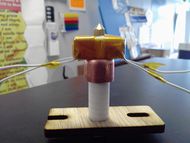J-Head Lite
Release status: developement
| Description | J-Head Lite- A minimalistic spin On the J-Head nozzle
|
| License | Creative Commons Share Alike
|
| Author | |
| Contributors | |
| Based-on | |
| Categories | |
| CAD Models | |
| External Link |
Introduction
No sugar added!
It basically combines the holder of the J-Head, the heat sink of the Budaschnozzle, and the hot end of the MK7. The J-Head Lite uses a 1/2" reprocessed PTFE holder with a 6mm stainless steal tube whereas a traditional J-head uses a 5/8 PEEK holder with an 8mm PTFE lined brass tube. The heat sink is actually just a simple plumbing cap with a hole through it and mounted with a brass nut: simple, low tech, effective. The hot end is based off of the MK7, except it uses a 3w resistor and a thermistor instead of a 40W heater and a thermocouple. I tried to take the best parts of "the big 3" hot end designs and make something that's an economical alternative for ABS/PLA printing. Did I mention it's only 1.5oz?
After probing around the hot end at 240C with a thermistor, I found the brass nut on the heat sink gets to 170C, the middle of the stainless steal tube gets to 110C and the top gets to 80C. To be on the safe side, I'll call the max temp 250C.
Instead of using a brass barrel, I use a stainless steal barrel, much like what is used in the current Makerbot extruder design. I, and they, did this because stainless steal has less thermal conductivity than brass. This means less heat travels up the barrel. I also added a heat sink which mounts to the top of the heater block, separated by ceramic insulation. The brass nut, which clamps the heat sink down, absorbs heat as it travels up the barrel and dissipates it through the heat sink. The PTFE is separated from the heat sink by air, which is actually a great insulator. Simply by not touching the PTFE, the heat sink is unable to transmit its thermal energy through conduction. This thermal management helps resists thermal expansion in the PTFE.
Thermal expansion is the cause of PTFE loosening during extrusion. As the amount of force required to push the filament down the barrel and through the nozzle is much less with 1.75mm filament vs. 3mm filament (2-3 times less I think), less force is ultimately required to keep the barrel in place. So, with the right thermal management and the smaller filament size, PTFE is a pretty effective and economical alternative to PEEK.
Although It doesn't look like a very complex design, it's sometimes easier to do more with less and there's quite a lot of interesting thermodynamics going on here. With this minimalist design, a respectable hot end can be made at a fraction of the cost vs. a traditional J-Head. Hence, I deemed it the J-Head Lite.
PLA USERS: Soak a cotton ball with vegetable oil and feed the filament through it in order to stop it from sticking. http://www.makerbot.com/blog/2010/02/06/oil-helps-pla-yes/
Made out of:
| 1/2" reprocessed PTFE | (McMaster-Carr # 8803K14) |
| Laser cut oak mounting plate | (Lowes 1/4" Oak) |
| M6x1 stainless steal barrel | (McMaster-Carr # 90024A461) |
| Aluminum heater block | (Clinton Aluminum .3750X.5000 FLT 6061) |
| Vishay 6.8ohm resistor | (Digikey # RWMA-6.8CT-ND) |
| Honeywell 100k thermistor | (Digikey # 480-3135-ND) |
| Brass nozzle | (McMaster-Carr # 8952K33) |
| Ceramic insulation | (Mcmaster-Carr # 87575K85) |
| Heat Resistant Wiring | (skygeek.com # M22759/16-22-0) |
| Copper Heat Sink | (McMaster-Carr # 5520K44) |
